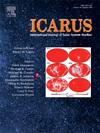Transient and tidal wave precursors and atmospheric impacts of Mars’ flushing storm initiated regional storms in reanalysis data
IF 2.5
2区 物理与天体物理
Q2 ASTRONOMY & ASTROPHYSICS
引用次数: 0
Abstract
Regional dust storms develop in the Southern Hemisphere (SH) of Mars typically three times in years that do not experience a Global Dust Storm. The Thermal Emission Spectrometer and the Mars Climate Sounder instruments on board Mars Global Surveyor and Mars Reconnaissance Orbiter, respectively, have observed that the storms that generally appear in the and time periods, commonly referred to as A- and C-season regional dust storms, respectively, are preceded by atmospheric dust ‘flushed’ into the SH from the Northern Hemisphere (NH) mid-latitude storm track through one of the vast lowland channels, most frequently via Acidalia–Chryse or Utopia–Isidis. Here, reanalysis data are used to analyze the typical behavior of transient and tidal waves before and after cross-equator flushing storms that trigger regional storms, revealing the characteristic atmospheric wave evolution surrounding these events. In particular, the analysis shows that a strong wavenumber 3 transient wave and a mid-latitude tide amplification typically precede flushing events. Furthermore, our results suggest that while Acidalia-related regional storms typically require multiple high-amplitude wave events, regional storms initiated through Isidis may happen more abruptly.
再分析资料中火星冲刷风暴引发区域风暴的瞬态和潮汐波前兆及大气影响
区域性沙尘暴在火星南半球(SH)发展,通常在没有经历全球沙尘暴的年份里有三次。火星全球勘测器和火星勘测轨道器上的热发射光谱仪和火星气候探测仪分别观测到,通常出现在Ls=210°- 240°和Ls=310°- 330°时间段的风暴,通常分别被称为A季和c季区域性沙尘暴,在此之前,大气尘埃从北半球(NH)中纬度风暴路径通过一个巨大的低地通道“冲”进北半球。最常见的是通过Acidalia-Chryse或Utopia-Isidis。本文利用再分析数据分析了触发区域风暴的跨赤道冲刷风暴前后的瞬态波和潮汐波的典型行为,揭示了这些事件周围的特征大气波演变。特别是,分析表明,在冲刷事件发生之前,通常会有一个强波数3的瞬态波和一个中纬度潮汐放大。此外,我们的研究结果表明,虽然与酸性有关的区域风暴通常需要多个高振幅波事件,但通过伊西迪斯引发的区域风暴可能会更突然地发生。
本文章由计算机程序翻译,如有差异,请以英文原文为准。
求助全文
约1分钟内获得全文
求助全文
来源期刊

Icarus
地学天文-天文与天体物理
CiteScore
6.30
自引率
18.80%
发文量
356
审稿时长
2-4 weeks
期刊介绍:
Icarus is devoted to the publication of original contributions in the field of Solar System studies. Manuscripts reporting the results of new research - observational, experimental, or theoretical - concerning the astronomy, geology, meteorology, physics, chemistry, biology, and other scientific aspects of our Solar System or extrasolar systems are welcome. The journal generally does not publish papers devoted exclusively to the Sun, the Earth, celestial mechanics, meteoritics, or astrophysics. Icarus does not publish papers that provide "improved" versions of Bode''s law, or other numerical relations, without a sound physical basis. Icarus does not publish meeting announcements or general notices. Reviews, historical papers, and manuscripts describing spacecraft instrumentation may be considered, but only with prior approval of the editor. An entire issue of the journal is occasionally devoted to a single subject, usually arising from a conference on the same topic. The language of publication is English. American or British usage is accepted, but not a mixture of these.
 求助内容:
求助内容: 应助结果提醒方式:
应助结果提醒方式:


